 General
General  General Archive
General Archive  Top Cleveland Sports Figures, By the Numbers - #27
Top Cleveland Sports Figures, By the Numbers - #27
This is one installment in a team effort by The Cleveland Fan, highlighting the top local sports figures by jersey number. Please weigh in with your thoughts, in the Boards. As David Letterman would say, “For entertainment purposes only; please, no wagering.”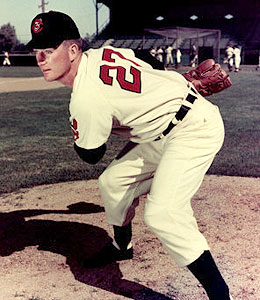 Herb Score’s selection as this town’s best ever #27 should serve as evidence that greatness is not measured in years. Score’s star burned white-hot for two seasons as a Cleveland Indian, earning him favorable comparisons with his legendary teammate Bob Feller, and widespread predictions that he would become one of the greatest left-handed pitchers ever to play the game.
Herb Score’s selection as this town’s best ever #27 should serve as evidence that greatness is not measured in years. Score’s star burned white-hot for two seasons as a Cleveland Indian, earning him favorable comparisons with his legendary teammate Bob Feller, and widespread predictions that he would become one of the greatest left-handed pitchers ever to play the game.
Score set a rookie record for strikeouts on his way to the Rookie of the Year award in 1955. He overshadowed another rookie pitcher who came into the league that same year...a Dodger lefty named Sandy Koufax. He was a 20-game winner by the age of 23. Leo Durocher called him “the fastest pitcher I’ve seen in 20 years”. That his career was brief made it no less brilliant.
Few Cleveland fans today are even aware that Score wore #27, because they know Herb Score mostly as a man without a uniform...as the radio voice of the Tribe, from their earliest recollection up until his retirement after the 1997 World Series. But perhaps the best known fact of all about Score is that his highly promising baseball career was started on its tragic downward trajectory when he was struck in the face by a line drive off the bat of the Yankees’ Gil McDougald early in the 1957 season.
Within moments of the ball striking Score in the eye, his career, if not his life, was in dire jeopardy. McDougald was disconsolate afterwards, saying he would quit the game if Score lost his eye. Fans from all over the country sent their best wishes. People everywhere felt sorry for the young Tribe lefty.
Herb Score was never one of them.
---
Tell Me About It
You can’t roll out of bed these days without being confronted with another story of an athlete who has “overcome adversity” on his way to success. Often this amounts to little more than putting a stop to his own selfish substance abuses, or maturing his way out of youthful lapses in judgment. All well and good of course, but some of these kids might do well to learn the story of Herb Score, for whom a devastating line drive to the head was not even the hardest thing to overcome.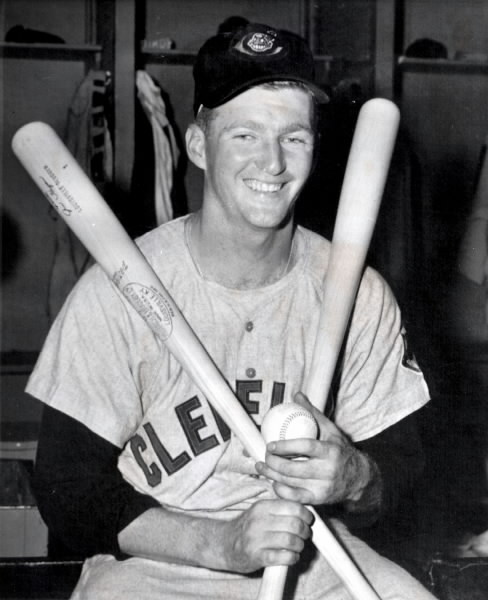 Score was born in Queens, NY, and the story of his early years is a litany of lousy luck. At the age of 3, he was struck by a bakery truck, severely injuring both legs above the knees. For a time, doctors questioned whether he would ever walk normally, but he made a full recovery. (Incredibly, it was not to be the last time he was hit and grievously injured by a truck.)
Score was born in Queens, NY, and the story of his early years is a litany of lousy luck. At the age of 3, he was struck by a bakery truck, severely injuring both legs above the knees. For a time, doctors questioned whether he would ever walk normally, but he made a full recovery. (Incredibly, it was not to be the last time he was hit and grievously injured by a truck.)
As a young child he missed an entire year of school with rheumatic fever. He survived severe cases of pneumonia and appendicitis when he was still a schoolboy. Later, as a young ballplayer in the minors, Score’s broken ankle from a fall in the shower, and his separated collarbone from a fall on wet outfield grass seemed minor by comparison.
All that helps to explain his constant upbeat attitude, and his refusal to ever allow self-pity to infect him. Even as he lay on the ground on that May evening at Cleveland Stadium, bleeding from the eye, with a broken nose, facial lacerations and internal hemorrhaging, he was joking with friend and teammate Mike Garcia, quipping, “Well, Bear...you can’t say I didn’t keep my eye on the ball”.
That was Herb Score...never afraid to make a joke at his own expense. Grateful for his many opportunities....to play baseball, to have a family, and to remain in the game when his playing days were over. To never look back in regret...only in appreciation.
Score never blamed either his eye injury, or the arm problems that beset him while he was trying to come back, for ending his career prematurely. His explanation: “I lost my job because I quit pitching well”. No excuses. No regrets.
But back to that white-hot start...
---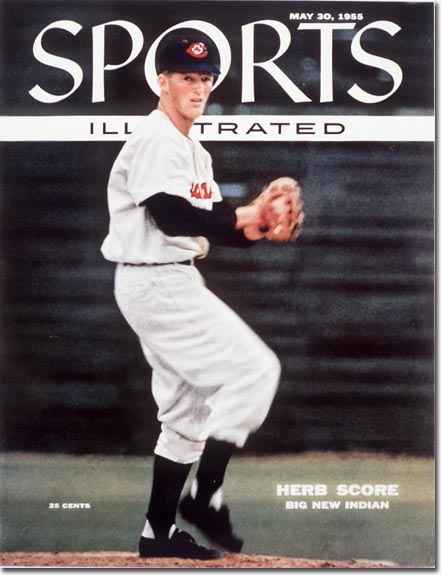 Herb Score was signed right out of high school by Tribe super-scout Cy Slapnicka, and by the summer of 1954, when he turned 21, he would go 22-5 for Indianapolis of the American Association (AAA), with an astounding 330 strikeouts, and complete games in two-thirds of his starts. The kid was wild too, walking 140 batters in 251 innings, but he still earned a spot on the Indians big league roster the following year.
Herb Score was signed right out of high school by Tribe super-scout Cy Slapnicka, and by the summer of 1954, when he turned 21, he would go 22-5 for Indianapolis of the American Association (AAA), with an astounding 330 strikeouts, and complete games in two-thirds of his starts. The kid was wild too, walking 140 batters in 251 innings, but he still earned a spot on the Indians big league roster the following year.
He was joining an Indians pitching staff fresh off a World Series, and one that still boasted Bob Feller and Bob Lemon among other standouts, but Score secured a spot in the rotation fairly early, and unlike his fellow-rookie Koufax in Los Angeles, he was able to get regular starts throughout the season. Still 21 when he made his first start, he pitched a complete game win over Detroit, striking out nine and walking nine.
Score pitched back-to-back one run complete games in his fourth and fifth starts, with 26 strikeouts, including a 16-strikeout game. By the end of May of his rookie year, Score was on the cover of Sports Illustrated, with the sub-heading “Big New Indian”.
He struggled a bit in mid-season, but came on strong toward the end, winning seven of his last eight decisions to finish 16-10, with a 2.45 ERA and 245 strikeouts, 35 more than anyone else in the major leagues. The strikeout total was a rookie record that would stand for 29 years, until Dwight Gooden broke it in 1984, and it still stands as the American League mark.
On that Rookie of the Year resume in 1955 for Score was a 1-hitter, a 2-hitter, and three 3-hitters to go with the record for strikeouts. The only down side was the wildness, as Score averaged six walks per nine innings. That was forgivable, because as his close friend and teammate Rocky Colavito observed, “They didn't have a radar gun then to measure speed. But I think he threw 100 miles an hour."
By his second season, at the tender age of 23, Score was already established as the best left-hander in baseball. He finished the season on a roll once again, with five straight complete game wins down the stretch to end the 1956 campaign at 20-9, with an ERA of 2.53.
The sky was the limit for Herb Score. The Sporting News ran a feature after the season titled “Will Herb Score be the Greatest Lefthander?” In a day when entire franchises sold for $3-4 million, Boston’s Joe Cronin offered the Indians a million dollars for Herb Score. Tribe G.M. Hank Greenberg said he wouldn’t sell Score for twice that much.
The Beginning of the End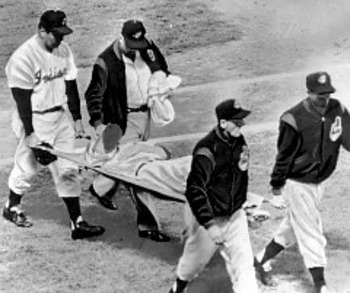 It was May 7, 1957. Score was off to an excellent start for the season, despite having lost a tough 11-inning complete game to the White Sox in his first start. He was 2-1 with a 2.00 ERA when he took the mound against the Yankees that night. He retired the first batter of the game before McDougald’s liner off a low fastball came screaming back at the mound.
It was May 7, 1957. Score was off to an excellent start for the season, despite having lost a tough 11-inning complete game to the White Sox in his first start. He was 2-1 with a 2.00 ERA when he took the mound against the Yankees that night. He retired the first batter of the game before McDougald’s liner off a low fastball came screaming back at the mound. 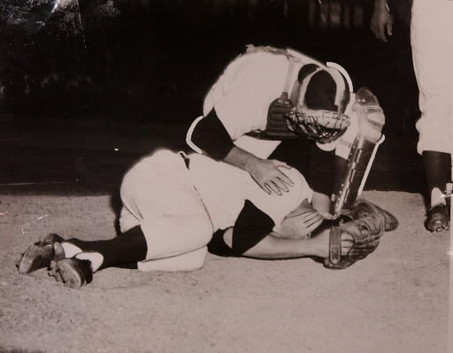 “I didn’t see the ball until it was a foot or two from my face,” said Score. McDougald ran directly to the mound rather than go to first base. Score’s roommate and best friend Rocky Colavito made record time from right field to the mound. There was lots of blood right away. First baseman Vic Wertz came to the mound, saw the blood and turned back. Score said everyone was throwing towels at him...he got one in his mouth and nearly choked on it.
“I didn’t see the ball until it was a foot or two from my face,” said Score. McDougald ran directly to the mound rather than go to first base. Score’s roommate and best friend Rocky Colavito made record time from right field to the mound. There was lots of blood right away. First baseman Vic Wertz came to the mound, saw the blood and turned back. Score said everyone was throwing towels at him...he got one in his mouth and nearly choked on it.
McDougald and his Yankee teammates Yogi Berra and Hank Bauer tried to get in to see Score in the hospital the next day, but they weren’t allowing visitors. Score spent three weeks at Lakeside Hospital before beginning the long comeback trail. He missed the rest of the 1957 season, as his vision slowly returned to normal, eventually getting back to 20/20.
The Arm Did It
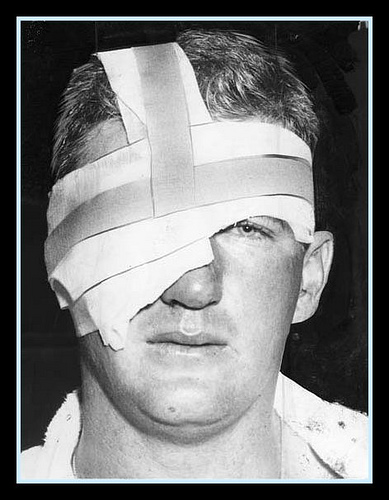 In fact, Score has always disputed the contention that his injury in May of ‘57 had anything to do with his career being cut short. He was pitching well at the outset of the ‘58 season, and according to what he told author Terry Pluto during the writing of The Curse of Rocky Colavito, Score was feeling as good as he ever had that spring when he tore a tendon in his elbow on a damp night against the Senators.
In fact, Score has always disputed the contention that his injury in May of ‘57 had anything to do with his career being cut short. He was pitching well at the outset of the ‘58 season, and according to what he told author Terry Pluto during the writing of The Curse of Rocky Colavito, Score was feeling as good as he ever had that spring when he tore a tendon in his elbow on a damp night against the Senators. 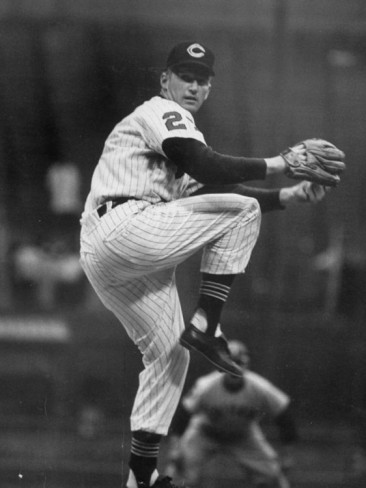 Score sat out the rest of the season, and then when he came back in 1959, he changed his mechanics to compensate for the injured elbow, and ended up getting his whole delivery out of whack and losing his velocity along the way. He had some good days and some bad days in the first half of the ‘59 season, and managed to be 9-5 at the All Star break, but he didn’t win another game, and finished at 9-11.
Score sat out the rest of the season, and then when he came back in 1959, he changed his mechanics to compensate for the injured elbow, and ended up getting his whole delivery out of whack and losing his velocity along the way. He had some good days and some bad days in the first half of the ‘59 season, and managed to be 9-5 at the All Star break, but he didn’t win another game, and finished at 9-11.
The day after the Indians’ Frank Lane traded Rocky Colavito, (see The Curse of...) on April 18, 1960, he traded Score to the White Sox for right-handed pitcher Barry Latman. Score continued to struggle in Chicago, going 5-10 in 1960. The last victory of his career came in early 1961 at Comiskey Park, when he threw a complete game 2-hitter with 13 strikeouts against...you guessed it...the Cleveland Indians.
After winning 36 games in his first two seasons in the majors, Score would win just 19 more over the next six years. As his playing days came to a close, he couldn’t have known that his association with major league baseball would continue for another 34 years.
---
Herbie on the Air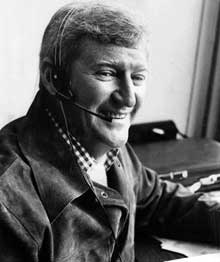 By 1963, Ken Coleman had been broadcasting both Browns and Indians games for several years, when Indians management pressed him for a decision to do one or the other. Coleman chose the Browns, and Score was there to take on the Indians broadcast duties. He started out doing TV for four years with Bob Neal, and then replaced the legendary Jimmy Dudley on the radio broadcasts starting in 1968.
By 1963, Ken Coleman had been broadcasting both Browns and Indians games for several years, when Indians management pressed him for a decision to do one or the other. Coleman chose the Browns, and Score was there to take on the Indians broadcast duties. He started out doing TV for four years with Bob Neal, and then replaced the legendary Jimmy Dudley on the radio broadcasts starting in 1968.
Score would eventually pair up with Joe Tait, Nev Chandler, Steve Lamar, Paul Olden, and finally Tom Hamilton before hanging it up in 1997. Never the smoothest or most eloquent of broadcasters, “Herbie” became a fan favorite nonetheless. He was well known for his frequent malaprops and mispronunciations, but he knew the game, and always made it his goal for the fans to remember what happened in the game rather than anything he said.
That wasn’t always easy to do, especially when he would blurt out some of his more famous Herbieisms (several of them listed by Bill Livingston here). Describing a shot down the line into the outfield, he once exclaimed, “Is it fair? Is it foul? It is!”
And I swear I remember hearing him describing a 2-base hit with, “and he slides into second with a stand-up double”. When he would momentarily lose track of the city he was in, or the team the Indians were facing, his broadcast partner would gently remind him, and the fans would always forgive.
Yet Another Comeback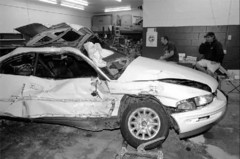 The day after being inducted into the Broadcasters Hall of Fame in 1998, Score was getting started driving to Florida for a vacation when he pulled out into the path of a tractor trailer near New Philadelphia. It was a horrific crash, and Score was pulled from the car unconscious with serious injuries...bruises to the brain and lungs, facial fractures and lacerations. He was placed on a ventilator and was in critical condition for weeks, but just as he had after his first encounter with a truck years before, Herb Score summoned the will to fight back.
The day after being inducted into the Broadcasters Hall of Fame in 1998, Score was getting started driving to Florida for a vacation when he pulled out into the path of a tractor trailer near New Philadelphia. It was a horrific crash, and Score was pulled from the car unconscious with serious injuries...bruises to the brain and lungs, facial fractures and lacerations. He was placed on a ventilator and was in critical condition for weeks, but just as he had after his first encounter with a truck years before, Herb Score summoned the will to fight back. 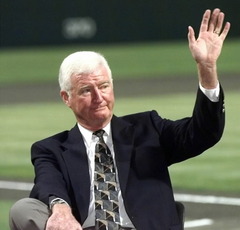 Score suffered a stroke in 2002, and was confined to a wheelchair when his friend Colavito accompanied him as he was inducted into the Indians Hall of Fame in 2006. Herb Score died in October of 2008 at the age of 75.
Score suffered a stroke in 2002, and was confined to a wheelchair when his friend Colavito accompanied him as he was inducted into the Indians Hall of Fame in 2006. Herb Score died in October of 2008 at the age of 75.
We only had Herb Score to watch for a few years as a player, and those were before most of us were around to pay attention...and yet by a quirk of fate, he is still synonymous with Indians baseball for millions of modern day Tribe fans.
He endured trials...and pain...and disappointment that most of us cannot imagine. And somehow he chose gratitude and grace as his answer to it.
And now you know what his number was.
----
Runner-Up at #27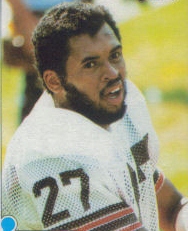 Thom Darden - Browns - Safety (1972-1981)
Thom Darden - Browns - Safety (1972-1981)
The Sandusky, OH native and Michigan Wolverine star was the first round selection of the Browns in 1972. Over the course of a nine-year career in Brown and Orange, Darden became the Browns’ career leader in interceptions with 45, a distinction he still holds today. In 1978, he led the NFL in interceptions with 10, and also in interception return yardage with 200 yds. Darden also returned punts for the team during his first three seasons in Cleveland. One particularly memorable moment in the safety’s career came against the Dallas Cowboys on Monday Night Football in 1979. The 3-0 Browns were meeting the 3-0 Cowboys in an early season showdown at Municipal Stadium. The Browns were already out to a surprising 13-0 lead in the first quarter behind Sipe, Newsome and Logan when Darden picked off a Roger Staubach throw over the middle, and took it to the house. (watch it here at the 4:35 mark). Dallas never recovered, and the Browns went on to a convincing 26-7 win, (much to Dandy Don’s dismay).
---
Other Cleveland #27’s
Jaret Wright - Indians - Pitcher - (1997-2002)
---
Mell Hall - Indians - OF - (1984-1988)
---
Walter “The Flea” Roberts - Browns - WR/KR - (1964-1966)
---
Al Gross - Browns - Safety - (1983-1987)
---
Leon “Daddy Wags” Wagner - Indians - OF - (1964-1968)
---
on Twitter at @dwismar
---
- NBA Announces 2013-2014 Schedule
- Browns Ink Sharknado
- Sharknado A No-Show For Rookie Camp
- Trent Richardson Out Until Training Camp
- Browns Sign Brandon Jackson
- Carrasco Suspended Eight Games
- Browns Add to Wide Receiver Depth with David Nelson
- Browns Need to Learn from Past Draft Mistakes
- Browns Release Chris Gocong and Usama Young
- Browns Missing on Grimes Disappointing, But Not The End
The TCF Forums
- Chris Grant's first 3 drafts
Kingpin74 (Tuesday, January 21 2014 10:13 AM) - The 2014 Offseason Thread
googleeph2 (Tuesday, January 21 2014 9:36 AM) - 2015 Recruiting
furls (Tuesday, January 21 2014 6:57 AM) - Mike Brown
YahooFanChicago (Monday, January 20 2014 11:15 PM) - Movies coming out
HoodooMan (Monday, January 20 2014 9:34 PM) - 2014 Hoops Hockey Hijinx
jpd1224 (Monday, January 20 2014 4:44 PM) - 2014 Recruiting
jclvd_23 (Monday, January 20 2014 2:26 PM) - Wish List - #4 Pick
Hikohadon (Monday, January 20 2014 1:26 PM) - Official- Browns Coach Search/Rumors
OldDawg (Sunday, January 19 2014 6:48 PM) - #1 overall pick Anthony Bennett
TouchEmAllTime (Sunday, January 19 2014 1:28 PM)


